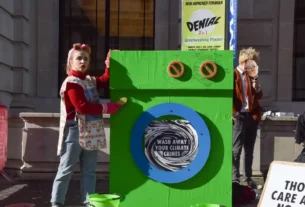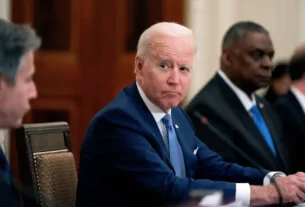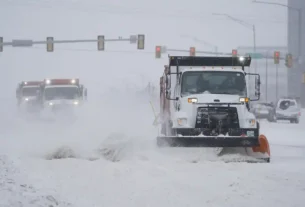
Administration is pledging to route 40% of the benefits of climate and environment spending to disadvantaged communities, but getting it right will be difficult
Indigenous farmers in the Isleta Pueblo, south of Albuquerque, New Mexico, have long relied on crops of corn and green chiles fed by the Rio Grande river, but amid a water crisis in the western US they are facing warnings to skip planting crops entirely –which could be devastating for the community’s 2,500 residents.
But a new national program could help those farmers and other disadvantaged communities. Introduced earlier this year by Joe Biden, the “Justice40” plan would steer 40% of the benefits of federal environmental investments to people most in need.The US ignored Louisiana’s ‘cancer alley’ for decades. Will Biden finally take action?Read more
For the Isleta Pueblo, that could mean funding for advanced irrigation or new sustainable revenue streams.
“We’ve been dealing with drought for decades. But this summer is actually going to be really, really dire for lots of indigenous, but also people of color farmers,” said Jade Begay of the NDN Collective, an indigenous-led justice organization that advocates for access to clean water.
Done right, experts say, the Justice40 program could designate millions or billions of dollars to communities in need and employ extensive planning and analysis. Done wrong, it could turn into a slush fund for pet projects that don’t necessarily reduce inequality. Just sending money to communities might not necessarily lead to local pollution reductions and to new, more sustainable jobs for the people who need them most.
The worsening threat of a hotter planet is a reality affecting communities across the US, but studies show that the people hit first and the hardest by climate change and pollution are largely non-white and poor.
“We’re talking about 400 years of challenges that have been placed on communities of color,” said Mustafa Santiago Ali, an environmental justice adviser to the Obama administration who is now vice-president of environmental justice, climate and community revitalization at the National Wildlife Federation.
“If we get really focused, we can make some significant changes in helping people’s health,” and in building wealth in communities, he said, with jobs like installing solar panels and capping orphaned oil and gas wells.
Ali called the program the “right move at the right time in history”, but said there were many ways the plan could fail, including as states become responsible for distributing funding. States across the country have not historically valued environmental justice, climate or science, he said.
The Biden administration enlisted more than two dozen advisers from various environmental justice groups for its White House Environmental Justice Advisory Council, which created a specific Justice40 working group. The council recently submitted recommendations that suggest broad investments in energy efficiency, sustainable and affordable housing, training and workforce development and pollution reduction.
The White House, in response to questions about concerns over how the program will be implemented, said that its Council on Environmental Quality, the Office of Management and Budget and other federal agencies were reviewing the council’s recommendations. They are also hearing input from congressional leaders and others, including on how success is defined and measured. In the coming days, the administration will publish interim guidance for agencies.
Ana Baptista, an assistant professor in the environmental policy and sustainability management graduate program at the New School, said there were many places in “dire need” of assistance, for water infrastructure and chemical safety. But she worried about those in Republican states like Kentucky and Florida, which have previously opposed some federal stimulus funding.
“My interpretation of this opposition is that it is largely political, seeking to thwart the federal administration’s efforts to help local economies and communities,” she said.
Activists also worry Justice40 could breed competition among communities of need. In California, for example, communities fought to rank high in the state’s environmental justice screening tool so they could qualify for the most funding, she said.
Many basics of the initiative have yet to be finalized and agreed upon, including how much money will flow into the program, where the benefits will be distributed and how. Coalmining regions in Appalachia; communities along Louisiana’s petrochemical corridor, known as “Cancer Alley”; and Indian reservations that lack access to water and power are likely candidates. But no specific towns or cities have yet been highlighted by the Justice40 program.
White House officials say the initiative is modeled on New York’s landmark Climate Leadership and Community Protection Act of 2019, which requires the state to invest or direct 40% of resources to disadvantaged communities. Yet advocates there said the Biden administration did not speak to frontline climate justice leadership in developing Justice40.
Elizabeth Yeampierre, who is on the steering committee for NYRenews, a New York-based environmental justice coalition, said she was surprised the administration didn’t contact the groups.
“If they had contacted us, instead of just taking it, they would have found that 40% is not the ceiling, it has to be the basement. And we aren’t talking about benefits, we are talking about investments,” she said.
In response to questions about how the administration picked the 40% figure, the White House said the initiative “is based on extensive engagement and feedback from environmental justice communities during the president’s campaign”.
Where the 40% or more of funding will come from, has not yet been specified, but hope hinges on Biden’s $2tn American Jobs Plan, which would open millions in aid to environmental justice and economic stimulus efforts. Without legislation from a divided Congress, though, the administration would have much less money to work with – able only to redirect some funds from various government agencies.
Despite the looming questions about how the program will work, advocates overall are energized by what they consider a serious and swift push to address climate change as shown by Justice40.
“I think we’re seeing a real commitment … and that feels so, so vastly different from the last four years,” said Begay of the NDN Collective, who is also a member of the White House Environmental Justice Advisory Council.
“We want to do the most that we possibly can in this time that we have with the access and the privilege we have.”



